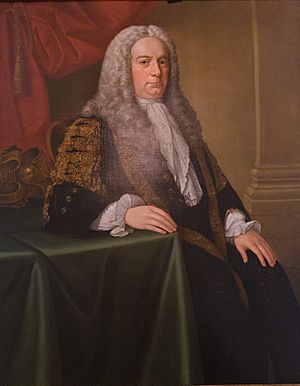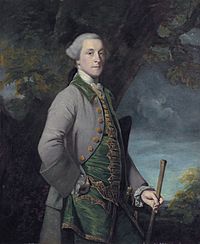Henry Boyle, 1st Earl of Shannon facts for kids
Quick facts for kids
The Earl of Shannon
PC
|
|
|---|---|
 |
|
| Speaker of the Irish House of Commons | |
| In office 1733–1756 |
|
| Monarch | George II |
| Preceded by | Sir Ralph Gore |
| Succeeded by | John Ponsonby |
| Member of Parliament for Midleton |
|
| In office 1707–1713 |
|
| Preceded by | St John Brodrick Robert Foulke |
| Succeeded by | Arthur Hyde Jephson Busteed |
| Member of Parliament for Kilmallock |
|
| In office 1713–1715 |
|
| Preceded by | John Ormsby Robert Oliver |
| Succeeded by | Kilner Brasier George King |
| Member of Parliament for County Cork |
|
| In office 1715–1756 |
|
| Preceded by | Sir John Perceval Alan Brodrick |
| Succeeded by | Arthur Hyde Charles Boyle |
| Personal details | |
| Born | c. 1682 Castlemartyr, County Cork |
| Died | December 28, 1764 (aged 81–82) Dublin, County Dublin |
| Spouses | Catherine Coote (m. 1715) Lady Henrietta Boyle (m. 1726) |
| Children | 6, including Richard and Robert |
| Education | Christ Church, Oxford |
Henry Boyle, 1st Earl of Shannon (born around 1682 – died December 28, 1764) was an important Irish politician. He served as the Speaker of the Irish House of Commons from 1733 to 1756. For nearly 50 years, Boyle was a parliamentarian in the Parliament of Ireland. He often stood up for Irish interests against British officials. This led to a big political problem, which ended with him leaving his role as Speaker to become an Earl.
Henry Boyle: A Powerful Irish Leader
Henry Boyle was born around 1682 in Castlemartyr, County Cork, in what was then the Kingdom of Ireland. His family was Anglo-Irish, meaning they were English settlers who had lived in Ireland for a long time.
Early Life and Education
Boyle's father, Henry Boyle, was an army officer. He died in 1693 while fighting in a war in Europe. Henry's mother was Lady Mary O'Brien.
Henry went to school in England at Westminster School in London. He even earned a special scholarship there in 1702. After Westminster, he studied at Christ Church College at the University of Oxford.
In 1705, Henry's older brother, Roger, passed away. This meant Henry inherited the family lands in Castlemartyr. These lands had been badly damaged during a war in Ireland.
Starting a Political Career
In 1707, Henry Boyle decided to become a politician. He was elected to the Irish House of Commons, which was part of the Parliament of Ireland. He first represented the area of Midleton.
He served for Midleton until 1713. Then he represented Kilmallock until 1714. In 1715, he was elected to represent County Cork, a role he held for many years.
Leading the Irish Parliament
By 1729, Henry Boyle was a very influential politician. He successfully stopped a bill in the Irish Parliament. This bill would have made Ireland send supplies to the British Crown for 21 years.
Sir Robert Walpole, who was like the Prime Minister of Great Britain, was impressed. He called Boyle "the King of the Irish Commons." In 1733, Boyle joined the Privy Council of Ireland, a group of important advisors.
The "Munster Squadron"
Boyle became the leader of a group of politicians called the "Munster squadron." Most of their support came from Cork and Waterford. This group helped Boyle become even more powerful.
In 1729, Boyle thought about becoming the Speaker of the Irish House of Commons. This is like the leader of the main part of Parliament. He decided not to run then, but his influence was growing.
Speaker of the House
On October 4, 1733, Henry Boyle was elected as the Speaker of the Irish House of Commons. In the same year, he also became the Chancellor of the Exchequer of Ireland. This was a well-paying job, giving him 800 pounds a year.
Boyle was also chosen many times to be a Lord Justice of Ireland. This meant he helped govern Ireland when the main British official, the Viceroy, was away.
For about 20 years, Boyle was one of the most important politicians in Ireland. He used his power to help Ireland's economy and industries. However, British officials often watched him closely. They were suspicious because he opposed some of their unpopular plans.
A Big Political Challenge

In 1753, a major political problem happened between Boyle and the Viceroy, the Duke of Dorset. It was about a "money bill." This bill, created by the British government, said that extra Irish tax money should go to Britain.
The Irish Parliament, led by Boyle, refused to pass this bill. Because of this, the Duke of Dorset closed Parliament in 1754. He also removed Boyle from all his official jobs.
Boyle fought back against his dismissal. This argument became a big struggle. It was about whether the British or Irish Parliament had the final say over Ireland's money.
A New Viceroy and a Deal
Britain was worried about a possible war with France. The political unrest in Ireland also caused problems. So, in 1755, the Duke of Dorset was replaced by the Marquess of Hartington.
The new Viceroy quickly made a deal with Boyle. Boyle agreed to step down as Speaker. In return, he would be made an Earl of Shannon, a high rank in the Irish nobility. He also received a yearly payment of 2,000 pounds for 31 years.
On April 17, 1756, Boyle officially stepped down as Speaker. He then took his new place in the Irish House of Lords.
Later Years and Death
After the crisis, some people criticized Boyle. They said he was not patriotic for making a deal with the Viceroy. But he still had many supporters in Parliament.
In 1758, he was asked to serve as Lord Justice again. This helped the British government gain more trust in the Irish Parliament.
Henry Boyle died on December 27, 1764, at his home in Dublin. He was 82 years old and died from a sudden attack of gout. He was buried in St Patrick's Cathedral four days later.
Family and Personal Life
Henry Boyle greatly improved his family's standing and wealth. He started from a less important background. He built up a strong political network and land ownership that lasted after him.
For many years, Boyle was a dominant figure in Irish politics. By 1753, he had about 40 members of parliament who supported him. He owned homes in Castlemartyr and Dublin. However, he preferred to spend most of his time at his family's estates in the countryside.
Boyle was very skilled at managing elections and helping people get political jobs. He became one of the most effective "parliamentary managers" in Ireland before 1800.
Marriages and Children
Boyle married his first wife, Catherine Coote, in 1715. They did not have any children, and she died in 1725.
On December 22, 1726, he married again to Lady Henrietta Boyle. She was a distant cousin. Together, they had five sons and one daughter. Henrietta died in 1746.
Three of Boyle's sons died when they were young. His oldest surviving son, Richard, inherited his father's titles when Henry died in 1764. Another son, Robert, joined the British Royal Navy.
Estates and Art
Boyle worked hard to fix and improve his estates at Castlemartyr. He also managed the Irish estates of the 2nd Earl of Burlington. He made these properties much more valuable.
In 1744, Boyle asked English artist Stephen Slaughter to paint his portrait. This oil-on-canvas painting is now part of the collection at the Palace of Westminster.
Contents |

